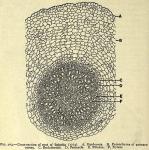439. Spigelia.—Pink Root. Carolina Pink.
The dried rhizome and roots of Spige'lia marilan'dica Linné.
BOTANICAL CHARACTERISTICS.—Root perennial; stem simple and erect. Leaves sessile, ovate-lanceolate, acute. Flowers in a short spike; corolla red externally, yellow within, four times the length of the calyx; stamens and pistil exserted.
HABITAT.—United States, Maryland southward and westward in rich woods.
 DESCRIPTION OF DRUG.—Rhizome thin, bent, purplish-brown, on the upper side marked with stem scars, on the lower side beset with numerous lighter colored, slender, branching rootlets. Fracture short. Odor slight, aromatic; taste sweetish, bitter, and pungent.
DESCRIPTION OF DRUG.—Rhizome thin, bent, purplish-brown, on the upper side marked with stem scars, on the lower side beset with numerous lighter colored, slender, branching rootlets. Fracture short. Odor slight, aromatic; taste sweetish, bitter, and pungent.
 RELATED SPECIES.—Another species which has attracted attention as an anthelmintic is Spigelia anthelmia of South America and the West Indies, which in that country is said to have greater medicinal properties than the official.
RELATED SPECIES.—Another species which has attracted attention as an anthelmintic is Spigelia anthelmia of South America and the West Indies, which in that country is said to have greater medicinal properties than the official.
A wholesale adulteration of this drug was discovered a short time ago. To the surprise of pharmacognosists this adulterant (a species of Ruellia) had completely replaced the official article in commerce, A cross-section of the authentic drug (rootlets and rhizome) is given in Figs. 203 and 204.
Powder.—Characteristic elements: See Part iv, Chap. I, B.
CONSTITUENTS.—A volatile alkaloid, spigeline, is the active principle. Ash, not more than 10 per cent.
Preparation of Spigeline.—Distil the powdered drug over a paraffin bath with milk of lime; collect the distillate in HCl and evaporate to dryness; crystallize from alcoholic solution.
ACTION AND USES.—A powerful anthelmintic. Dose: 15 to 60 gr. (1 to 4 Gm.).
- OFFICIAL PREPARATION.
- Fluidextractum Spigeliae Dose: 15 to 60 drops (1 to 4 mils).

